Remote Sensing-Based Analysis of Spatial and Temporal Water Colour Variations in Baiyangdian Lake after the Establishment of the Xiong’an New Area
Abstract
1. Introduction
2. Materials and Methods
2.1. Study Area
2.2. Study Data
2.2.1. Sentinel-2 Image Data
2.2.2. In Situ Remote Sensing Reflectance Data
2.3. Accuracy Evaluation of Indices
2.4. Waterbody Extraction
2.5. FUI Calculations
2.6. Temporal and Spatial Aggregation
3. Results and Discussion
3.1. Accuracy of Evaluation of FUI
3.2. Spatial Distribution
3.3. Seasonal Variations
3.4. Inter-Annual Variations
3.5. Deficiencies
4. Conclusions
Author Contributions
Funding
Data Availability Statement
Acknowledgments
Conflicts of Interest
References
- China to create Xiong’an New Area in Hebei. Available online: http://www.gov.cn/xinwen/2017–04/01/content_5182891.htm#1 (accessed on 1 April 2017).
- Xiong’an New Area Focuses on Comprehensive Improvement of Water Environment in Baiyangdian Basin. Available online: https://baijiahao.baidu.com/s?id=1597093148398412407&wfr=spider&for=pc. (accessed on 7 April 2018).
- Three Projects Were Formulated and 51 Projects Were Implemented. Xiong’an New Area Took Many Measures to Control and Repair the Ecological Environment of Baiyangdian Lake. Available online: https://kuaibao.qq.com/s/20191205A0SLWQ00?refer=spider (accessed on 5 December 2019).
- Pearl of North China Reappears Vitality. Available online: http://news.hexun.com/2020–04–14/201012586.html (accessed on 14 April 2020).
- Xiong’an New Area, Hebei Province: Exploring a New Way to Control Endogenous Pollution. Available online: https://baijiahao.baidu.com/s?id=1677195894437407993&wfr=spider&for=pc (accessed on 8 September 2019).
- Fragam, R.S.; Guedes, H.A.S.; Martins, V.S.; Caballero, C.B.; Mendes, K.G.P.; Monks, J.L.F.; Fassoni-Andrade, A.C. Empirical modelling of suspended solids in a subtropical lagoon (Brazil) using linear spectral mixing algorithm. Remote Sens. Appl. Soc. Environ. 2020, 20, 100380. [Google Scholar]
- Wang, Q.; Yang, Y.; Wu, C.Q. Study of retrieving models for Chlorophyll-A concentration based on HJ-1A HIS images. Spacecr. Eng. 2009, 16, 133–137. [Google Scholar]
- Zhou, L.; Xu, B.; Ma, W.; Zhao, B.; Li, L.; Huai, H. Evaluation of Hyperspectral Multi-Band Indices to Estimate Chlorophyll-A Concentration Using Field Spectral Measurements and Satellite Data in Dianshan Lake. Water 2013, 5, 525–539. [Google Scholar] [CrossRef]
- Zhu, Y.F.; Zhu, L.; Li, J.G.; Chen, Y.J.; Zhang, Y.H.; Hou, H.Q.; Jiu, X.; Zhang, Y.Z. The study of inversion of chlorophyll a in Taihu based on GF-1 WFV image and BP neural network. Acta Sci. Circumstantiae. 2017, 1, 130–137. [Google Scholar]
- Saberioon, M.; Brom, J.; Nedbal, V.; Soucek, P.; Cisar, P. Chlorophyll-a and total suspended solids retrieval and mapping using Sentinel-2A and machine learning for inland waters. Ecol. Indic. 2020, 113, 106236. [Google Scholar] [CrossRef]
- Gao, Y.C.; Wang, H.; Long, D. Changes in hydrological conditions and the eco-environment problems in Baiyangdian Watershed. Resour. Sci. 2009, 31, 1506–1513. [Google Scholar]
- Li, Y.H.; Cui, B.S.; Yang, Z.F. Influence of hydrological characteristic change of Baiyangdian on the ecological environment in Wetland. J. Nat. Resour. 2004, 19, 62–68. [Google Scholar]
- Liu, K.; Zhang, L.; Zhang, G.; Liu, J.; Yan, M. The impact of human activities on runoff in Baiyangdian Basin in North China. J. China Hydrol. 2007, 27, 6–10. [Google Scholar]
- Gong, R. Water Change in Baiyangdian Lake and affecting factors. Geogr. Territ. Res. 1993, 9, 36–40. [Google Scholar]
- Wang, X.Y.; Wang, W.J.; Jiang, W.G.; Jia, K.; Rao, P.Z.; Lv, J.X. Analysis of the dynamic changes of the Baiyangdian Lake surface based on a complex water extraction method. Water 2018, 10, 1616. [Google Scholar] [CrossRef]
- Song, C.Q.; Ke, L.H.; Pan, H.; Zhan, S.G.; Liu, K.; Ma, R.H. Long-term surface water changes and driving cause in Xiong’an, China: From dense Landsat time series images and synthetic analysis. Sci. Bull. 2018, 11, 708–716. [Google Scholar] [CrossRef]
- Li, C.H.; Zheng, X.K.; Zhao, F.; Wang, X.; Cai, Y.P.; Zhang, N. Effects of urban non-point source pollution from Baoding City on Baiyangdian Lake, China. Water 2017, 9, 249. [Google Scholar]
- Liu, C.L.; Xie, G.D.; Huang, H.Q. Shrinking and drying up of Baiyangdian Lake wetland: A natural or human cause? Chin. Geogr. Sci. 2006, 16, 314–319. [Google Scholar] [CrossRef]
- Zhao, Y.; Xia, X.H.; Yang, Z.F.; Wang, F. Assessment of water quality in Baiyangdian Lake using multivariate statistical techniques. Procedia Environ. Sci. 2012, 13, 1213–1226. [Google Scholar] [CrossRef]
- Su, L.Y.; Liu, J.L.; Christensen, P. Spatial distribution and ecological risk assessment of metals in sediments of Baiyangdian wetland ecosystem. Ecotoxicology 2011, 20, 1107–1116. [Google Scholar] [CrossRef]
- Zhang, M.; Gong, Z.N.; Zhao, W.J.; Duo, A. Landscape pattern change and the driving in Baiyangdian wetland from 1984–2014. Acta Ecol. Sin. 2016, 36, 4780–4791. [Google Scholar]
- Wang, T.T.; Cui, B.S.; Liu, P.P.; Lan, Y.; Han, Z.; Zhang, Y.T. Effect of floating plants on distributions of emergent and submerged plants in Baiyangdian Lake. Wetl Sci. 2013, 11, 266–270. [Google Scholar]
- Wang, X.D.; Liu, S.L.; Zhang, S.S.; Chen, J.W. Improvement of WASP Eutrophication Model in Baiyangdian Water Area. Environ. Sci. Technol. 2009, 10, 19–24. [Google Scholar]
- Yuan, Y.; Yan, D.H.; Wang, H.; Wang, Q. Attributive analysis on evolution of inflow to Baiyangdian wetland. J. Water Resour. Plan. Manag. 2013, 12, 1–4. [Google Scholar]
- Hu, S.S.; Zheng, H.X.; Liu, C.M.; Yu, J.J.; Wang, Z.G. Assessing the impacts of climate variability and human activities on streamflow in the water source area of Baiyangdian Lake. J. Geogr. Sci. 2012, 22, 895–905. [Google Scholar] [CrossRef]
- Liu, F.; Liu, J.J.; Zhang, T.; Chen, Q.Y. Land use change and its effects on water quality in Baiyangdian Lake of north China during last 20 Years. J. Agro-Environ. Sci. 2010, 29, 1868–1875. [Google Scholar]
- Zhao, Y.K.; Zhang, X.Q.; Ma, D.M. Baiyangdian functional area division principle. Environ. Sci. 1995, S1, 40–41. [Google Scholar]
- Wang, H.N.; Lv, X.Z.; Zhang, M.Y. Sensitivity and attribution analysis based on the Budyko hypothesis for streamflow change in the Baiyangdian catchment, China. Eco. Ind. 2021, 121, 107221. [Google Scholar]
- Zhu, H.; Liu, X.G.; Cheng, S.P. Phytoplankton community structure and water quality assessment in an ecological restoration area of Baiyangdian Lake, China. Int. J. Environ. Sci. Technol. 2020, 1735, 1–8. [Google Scholar] [CrossRef]
- Zhao, Y.; Han, J.Y.; Zhang, B.; Gong, J.G. Impact of transferred water on the hydrochemistry and water quality of surface water and groundwater in Baiyangdian Lake, North China. Geosci. Front. 2020, 12, 101086. [Google Scholar] [CrossRef]
- Yan, S.; Yin, J.; Yuan, Z.; Yan, D.H.; Yuan, Y. Research on Drought Retrieve in Baiyangdian Basin, China. Earth Environ. Sci. 2020, 525, 012004. [Google Scholar] [CrossRef]
- Wang, S.; Li, J.; Zhang, B.; Spyrakos, E.; Tyler, A.N.; Shen, Q.; Zhang, F.; Kuster, T.; Lehmann, M.K.; Wu, Y.; et al. Trophic state assessment of global inland waters using a MODIS-derived Forel-Ule index. Remote Sens. Environ. 2018, 217, 444–460. [Google Scholar] [CrossRef]
- Wang, S.; Li, J.; Zhang, B.; Lee, Z.; Spyrakos, E.; Feng, L.; Liu, C.; Zhao, H.; Wu, Y.; Zhu, L.; et al. Changes of water clarity in large lakes and reservoirs across China observed from long-term MODIS. Remote Sens. Environ. 2020, 247, 111949. [Google Scholar] [CrossRef]
- Wang, S.L.; Li, J.S.; Shen, Q.; Zhang, B.; Zhang, F.; Lu, Z.Y. MODIS-based radiometric colour extraction and classification of inland water with the Forel-Ule scale: A case study of Lake Taihu. IEEE J. Sel. Top. Appl. Earth Obs. Remote Sens. 2015, 8, 907–918. [Google Scholar] [CrossRef]
- Van der Woerd, H.J.; Wernad, M.R. True colour classification of natural waters with medium-spectral resolution satellites: SeaWiFs, MODIS, MERIS and OLCI. Sensors 2015, 15, 25663–25680. [Google Scholar] [CrossRef]
- Alfoldi, T.; Munday, J. Water quality analysis by digital chromaticity mapping of Landsat data. Can. J. Remote Sens. 1978, 4, 108–126. [Google Scholar] [CrossRef]
- Jaquet, J.; Zand, B. Colour analysis of inland waters using Landsat TM data. ESA SP 1989, 1102, 57–67. [Google Scholar]
- Bukata, R.P.; Bruton, J.E.; Jerome, J.H. Use of chromaticity in remote measurements of water quality. Remote Sens. Environ. 1983, 13, 161–177. [Google Scholar] [CrossRef]
- Bukata, R.P.; Jerome, J.H.; Kondratyev, K.Y.; Pozdnyakov, D.V.; Kotykhov, A.A. Modeling the radiometric colour of inland waters: Implications to a) remote sensing and b) limnological colour scales. J. Great Lakes Res. 1997, 23, 254–269. [Google Scholar] [CrossRef]
- Li, J.S.; Wang, S.L.; Wu, Y.H.; Zhang, B.; Chen, X.L.; Zhang, F.F.; Shen, Q.; Peng, D.L.; Tian, L.Q. MODIS observations of the water colour of the largest 10 lakes in China between 2000 and 2012. Int. Digit. Earth 2016, 9, 788–805. [Google Scholar] [CrossRef]
- Shen, Q.; Yao, Y.; Li, J.S.; Zhang, F.F.; Wang, S.L.; Wu, Y.H.; Ye, H.P.; Zhang, B. A CIE colour purity algorithm to detect black and odorous water in urban rivers using high-resolution multispectral remote sensing images. IEEE Trans. Geosci. Remote Sens. 2019, 57, 6577–6590. [Google Scholar] [CrossRef]
- Wang, S.L.; Lee, Z.P.; Shang, S.L.; Li, J.S.; Lin, G. Deriving inherent optical properties from classical water colour measurements: Forel-Ule Index and Secchi disk depth. Opt. Express 2019, 27, 7642–7655. [Google Scholar] [CrossRef]
- Garaba, S.P.; Friedrichs, A.; Vofs, D.; Zielinski, O. Classifying natural waters with the Forel-Ule colour system: Results, applications, corrdations and crowdsourcing. Int. J. Environ. Res. Public Health 2015, 12, 16096–16109. [Google Scholar] [CrossRef]
- Zhao, Y.L.; Qian, S.; Wang, Q.; Yang, F.; Wang, S.L.; Li, J.S.; Zhang, F.F.; Yao, Y. Recognition of water colour anomalies by using hue angle and Sentinel-2 images. Remote Sens. 2020, 12, 716–736. [Google Scholar] [CrossRef]
- Petus, C.; Waterhous, J.; Lewis, S.; Vacher, M.; Tracey, D.; Devlin, M. A flood of information: Using Sentinel-3 water colour products to assure continuity in the monitoring of water quality trends in the Great Barrier Reef (Australia). J. Environ. Manag. 2019, 248, 109255. [Google Scholar] [CrossRef]
- Sidik, M.J.; Bower, D.G.; Griffiths, J.W. Remote sensing observations of ocean colour using the traditional Forel-Ule Scale. Estuar. Coast. Shelf Sci. 2018, 215, 52–58. [Google Scholar] [CrossRef]
- Nie, Y.F.; Guo, J.T.; Sun, B.N.; Lv, X.Q. An evaluation of apparent colour of seawater and on the in-situ and satellite-derived Forel-Ule colour scale. Estuar. Coast. Shelf Sci. 2020, 246, 107032. [Google Scholar] [CrossRef]
- Pitarch, J.; Bellacicco, M.; Marullo, S.; Van der Woerd, H. Global maps of Forel-Ule Index, hue angle and Secchi disk depth derived from twenty-one years of monthly ESA-OC-CCI data. Earth Syst. Sci. Data 2020, 316. [Google Scholar]
- Patel, N.N.; Angiuli, E.; Gamba, P.; Gaughan, A.; Lisini, G.; Stevens, F.R.; Tatem, A.J.; Trianni, G. Multitemporal settlement and population mapping from Landsat using Google Earth Engine. Int. J. Appl. Earth Obs. Geoinf. 2015, 35, 199–208. [Google Scholar] [CrossRef]
- Liu, X.P.; Hu, G.H.; Chen, Y.M.; Li, X.; Pei, F.S. High-resolution multi-temporal mapping of global urban land using Landsat images based on the Google Earth Engine platform. Remote Sens. Environ. 2018, 209, 227–239. [Google Scholar] [CrossRef]
- Sidhu, N.; Pebesma, E.; Camara, G. Using Google Earth Engine to detect land cover change: Singapore as a use case. Eur. J. Remote Sens. 2018, 51, 486–500. [Google Scholar] [CrossRef]
- Dong, J.W.; Xiao, X.M.; Menarguez, M.A.; Zhang, G.L.; Qin, Y.W.; Thau, D.; Biradar, C.; Moore, B. Mapping paddy rice planting area in northeastern Asia with Landsat 8 images, phenology-based algorithm, and Google Earth Engine. Remote Sens. Environ. 2016, 185, 142–154. [Google Scholar] [CrossRef]
- Gorelick, N.; Harcher, M.; Dixon, M.; Ilyushchenkob, S.; Thau, D.; Moore, R. Google Earth Engine planetary-scale geospatial analysis for everyone. Remote Sens. Environ. 2017, 202, 18–27. [Google Scholar] [CrossRef]
- Gui, B.S.; Li, X.; Zhang, K.J. Classification of hydrological conditions to assess water allocation schemes for Lake Baiyangdian in North China. J. Hydrol. 2010, 385, 247–256. [Google Scholar]
- Yang, Z.F.; Mao, X.F. Wetland system network analysis for environmental flow allocations in the Baiyangdian basin, China. Ecol. Model. 2011, 222, 3785–3794. [Google Scholar] [CrossRef]
- Chen, J.; Zhu, W.N.; Tian, Y.Q.; Yu, Q.; Zheng, Y.H.; Huang, L.T. Remote estimation of colored dissolved organic matter and chlorophyll-a in Lake Huron using Sentinel-2 measurements. J. Appl. Remote Sens. 2017, 11, 036007. [Google Scholar] [CrossRef]
- Guo, H.W.; Huang, J.J.; Chen, B.; Guo, X.L.; Singh, V.P. A machine learning-based strategy for estimating non-optically active water quality parameters using Sentinel-2 imagery. Int. J. Remote Sens. 2020, 42, 1841–1866. [Google Scholar] [CrossRef]
- Wang, J.; Ding, J.; Yu, D.; Ma, X.; Zhang, Z.; Ge, X.; Teng, D.; Li, X.; Liang, J.; Lizaga, I.; et al. Capability of Sentinel-2 MSI data for monitoring and mapping of soil salinity in dry and wet seasons in the Ebinur Lake region, Xinjiang, China. Geoderma 2019, 353, 172–187. [Google Scholar] [CrossRef]
- Caballero, I.; Fernandez, R.; Escalante, O.M.; Maman, L.; Navarro, G. New capabilities of Sentinel-2A/2B satellites combined with in situ data for monitoring small harmful algal blooms in complex coastal waters. Sci. Rep. 2020, 10, 8743. [Google Scholar] [CrossRef]
- Toming, K.; Kutser, T.; Laas, A.; Sepp, M.; Paavel, B.; Noges, T. First Experiences in Mapping Lake Water Quality Parameters with Sentinel-2 MSI Imagery. Remote Sens. 2016, 8, 640–653. [Google Scholar] [CrossRef]
- Chen, J.; Zhu, W.N.; Tian, Y.Q.; Yu, Q. Monitoring dissolved organic carbon by combining Landsat-8 and Sentinel-2 satellites: Case study in Saginaw River estuary, Lake Huron. Sci. Total Environ. 2020, 718, 137374. [Google Scholar] [CrossRef]
- Tang, J.W.; Tian, G.L.; Wang, X.Y.; Wang, X.M.; Song, Q.J. The methods of water spectral measurement and analysis I: Above water method. J. Remote Sens. 2004, 8, 37–44. [Google Scholar]
- Ocean Optics Book. Available online: www.oceanopticbooks.info/view/overview-of-optical-oceannography/refelectance (accessed on 29 July 2017).
- Muller, J.L.; Fargion, G.S.; Mcclain, C.R. Ocean Optics Protocols for Satellite Ocean Colour Sensor Validation, Revision 4, Volume Ⅲ: Radiometric Measurements and Data Analysis Protocols; NASA/TM-2003–21621/Rev-VolⅢ; National Aeronautical and Space Administration: Washington, DC, USA, 2003.
- Gong, P.; Liu, H.; Zhang, M.; Li, C.; Wang, J.; Huang, H.; Clinton, N.; Ji, L.; Li, W.; Bai, Y.; et al. Stable classification with limited sample: Transferring a 30 m resolution sample set collected in 2015 to mapping 10 m resolution global land cover in 2017. Sci. Bull. 2019, 64, 370–373. [Google Scholar] [CrossRef]
- Feyisa, G.L.; Meilby, J.; Fensholt, R.; Proud, S.R. Automated water extraction index: A new technique for surface water mapping using Landsat imagery. Remote Sens. Environ. 2014, 140, 23–35. [Google Scholar] [CrossRef]
- McFeeters, S.K. The use of the normalised difference water index (NDWI) in the delineation of open water features. Int. J. Remote Sens. 1996, 17, 1425–1432. [Google Scholar] [CrossRef]
- Xu, H.Q. Modification of normalised difference water index (NDWI) to enhance open water features in remotely sensed imagery. Int. J. Remote Sens. 2006, 27, 3025–3033. [Google Scholar] [CrossRef]
- Wang, X.B.; Xie, S.P.; Zhang, X.L.; Chen, C.; Guo, H.; Du, J.K.; Duan, Z. A robust multi-band water index (MBWI) for automated extraction of surface water from Landsat 8 OLI imagery. Int. J. Appl. Earth Obs. Geoinf. 2018, 68, 73–91. [Google Scholar] [CrossRef]
- Capoa, M.; Pereza, A.; Lozanoa, J.A. An efficient approximation to the K-Means clustering for massive data. Knowl. Based Syst. 2017, 117, 56–59. [Google Scholar] [CrossRef]
- Exelis, 2010. Exelis Visual Information Solutions. Available online: http://www.exelisvis.com (accessed on 6 June 2014).
- CIE. Commission International de l’Eclairage Proceedings 1931; Cambridge University Press: Cambridge, UK, 1931; pp. 19–29. [Google Scholar]
- Van der Woerd, H.J.; Wernand, M.R. Hue-angle product for low to medium spatial resolution optical satellite sensors. Remote Sens. 2018, 10, 180. [Google Scholar] [CrossRef]
- Wang, M.X.; Yao, Y.; Shen, Q.; Gao, H.J.; Li, J.S.; Zhang, F.F.; Wu, Q.S. Time-Series Analysis of Surface-Water Quality in Xiong’an New Area, 2016–2019. J. Indian Soc. Remote Sens. 2021, 49, 857–872. [Google Scholar] [CrossRef]
- Liu, C.L.; Xie, G.D.; Xiao, Y. Impact of climatic change on Baiyangdian wetland. Res. Environ. Yangtze Basin 2007, 16, 245–250. [Google Scholar]
- Gao, Y.C.; Wang, J.F.; Feng, Z.M. Variation trend and response relationship of temperature, precipitation and runoff in Baiyangdian lake basin. Chin. J. Eco Agric. 2017, 25, 467–477. [Google Scholar]
- Liu, M.F.; Gao, Y.C.; Gan, G.J. Long-term trends in annual runoff and the impact of meteorological factors in the Baiyangdian watershed. Res. Sci. 2011, 33, 1438–1445. [Google Scholar]
- Yang, C.X. Analysis on the deposited quantity variation and its influenced factors in Baiyangdian. Ground Water 2010, 32, 110–112. [Google Scholar]
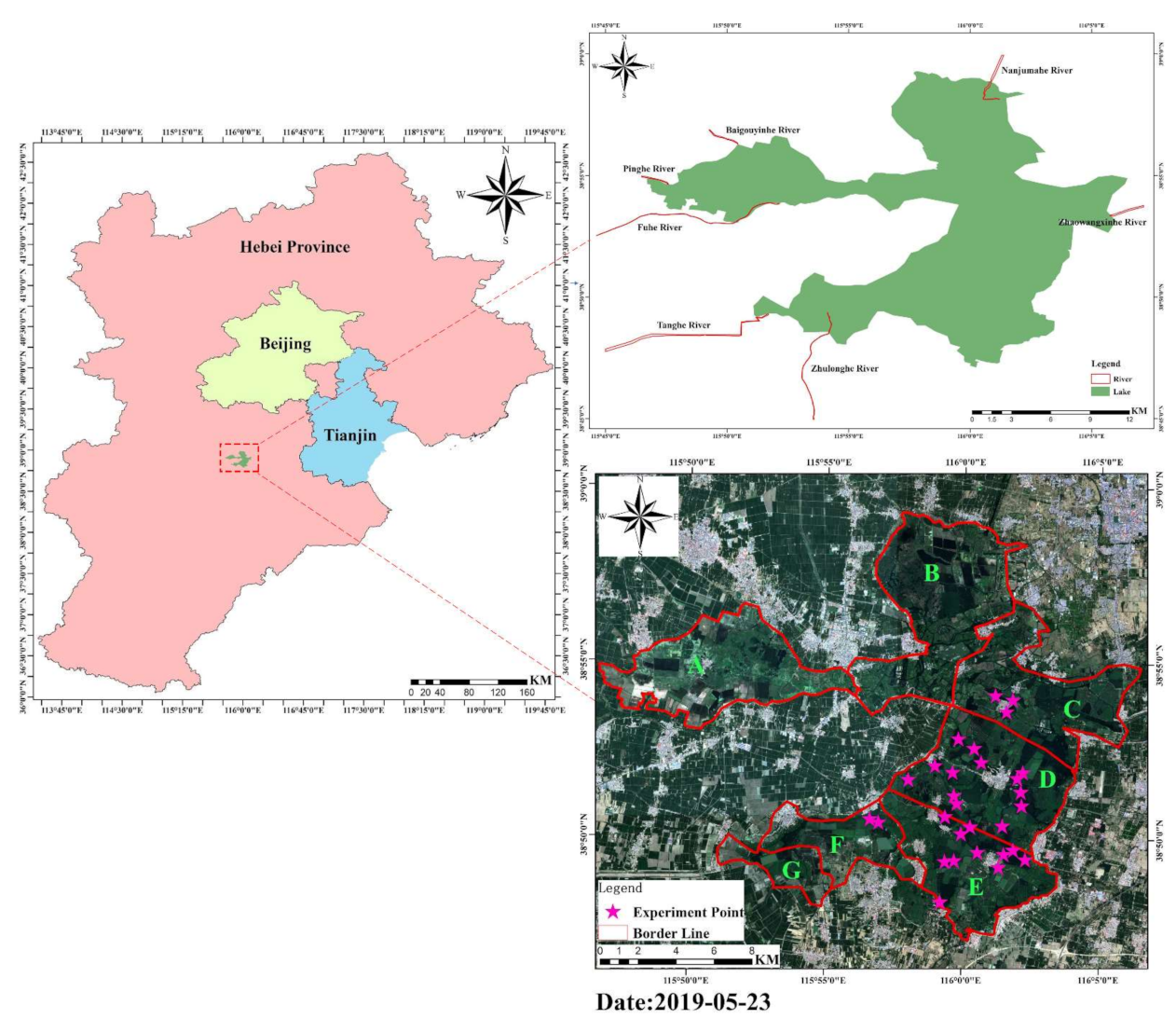

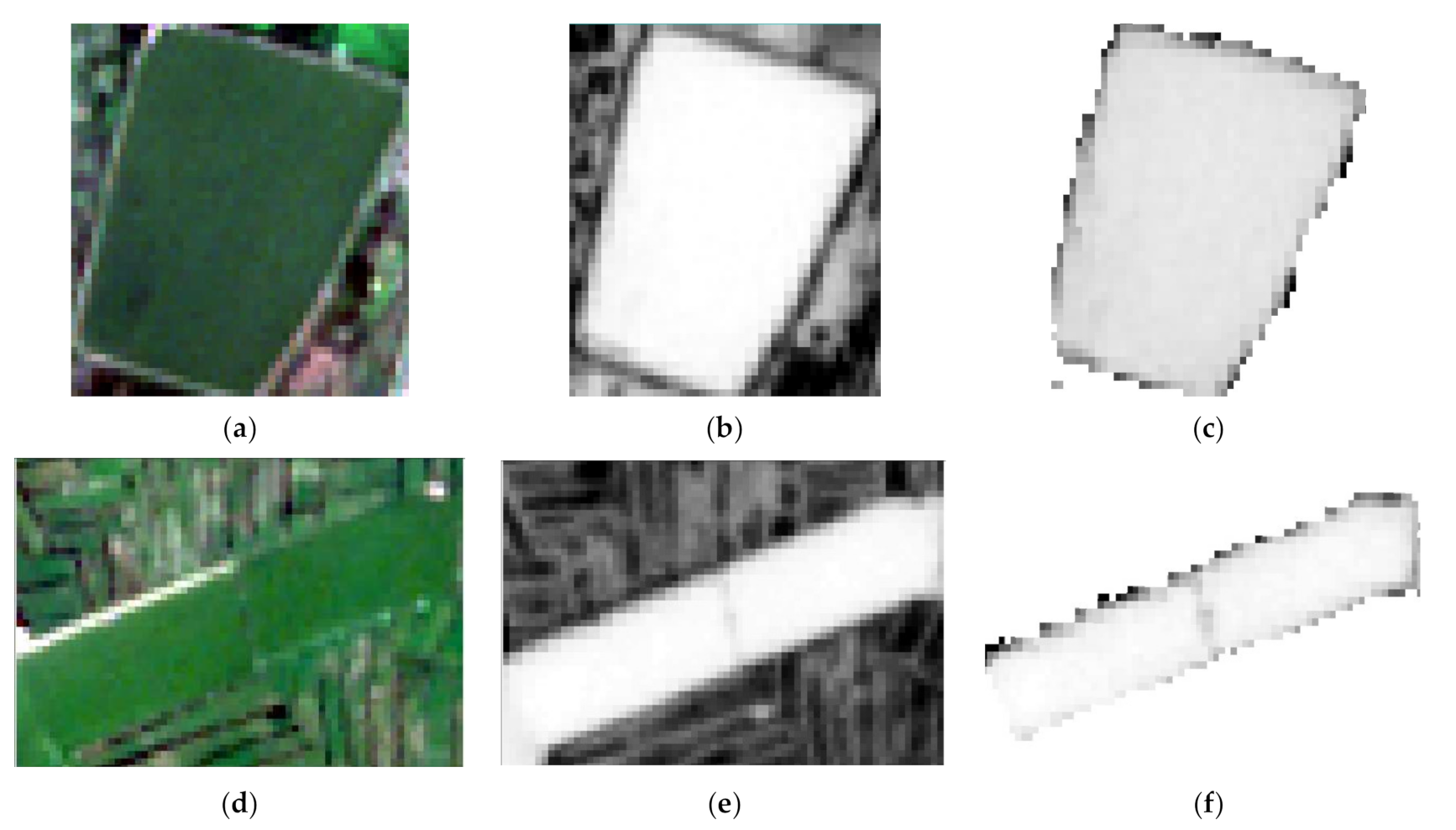
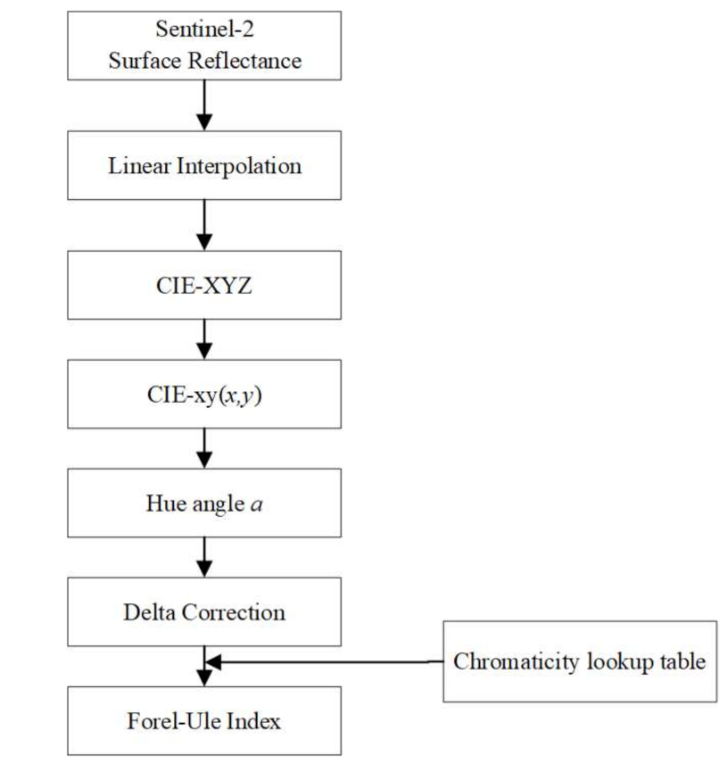

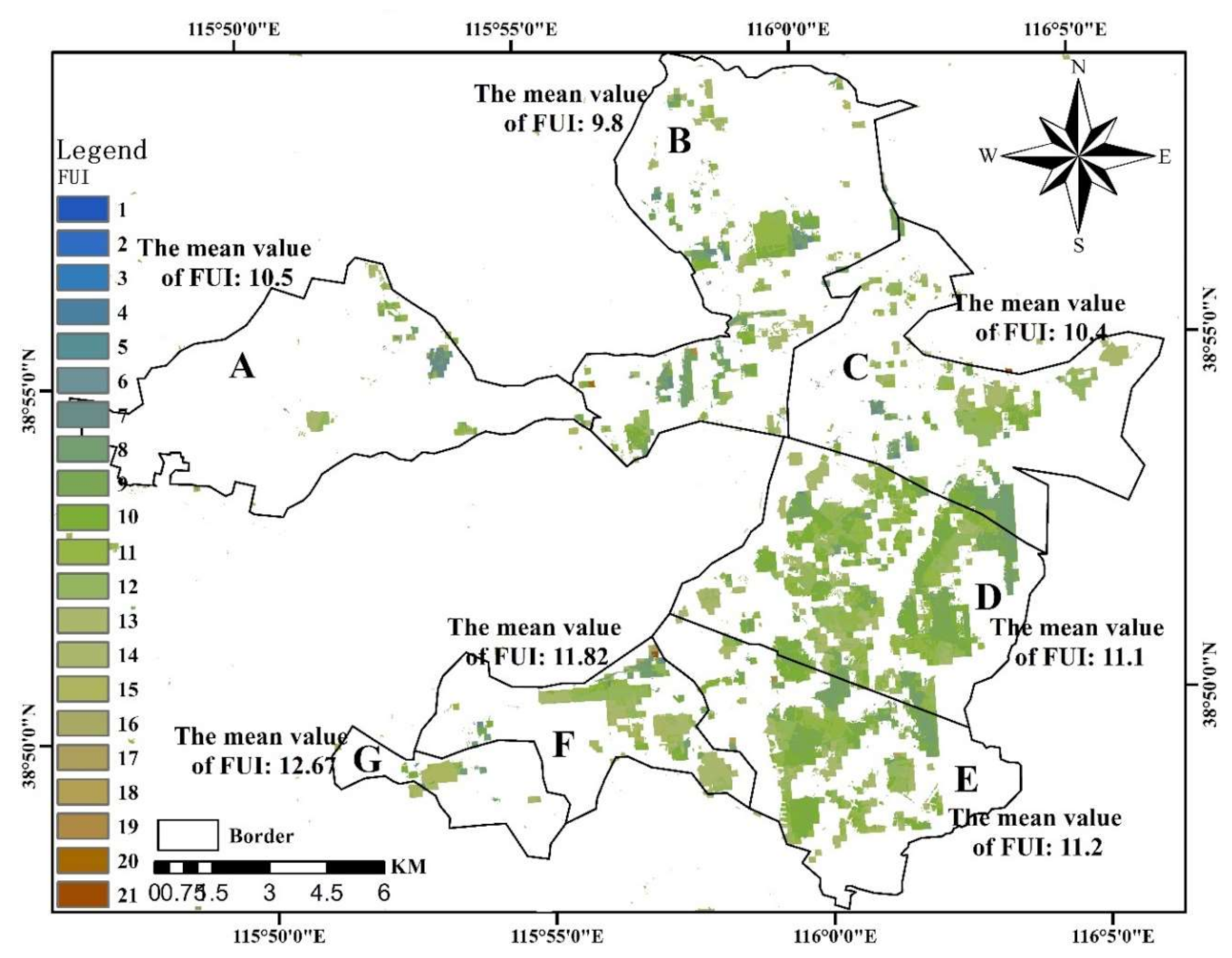
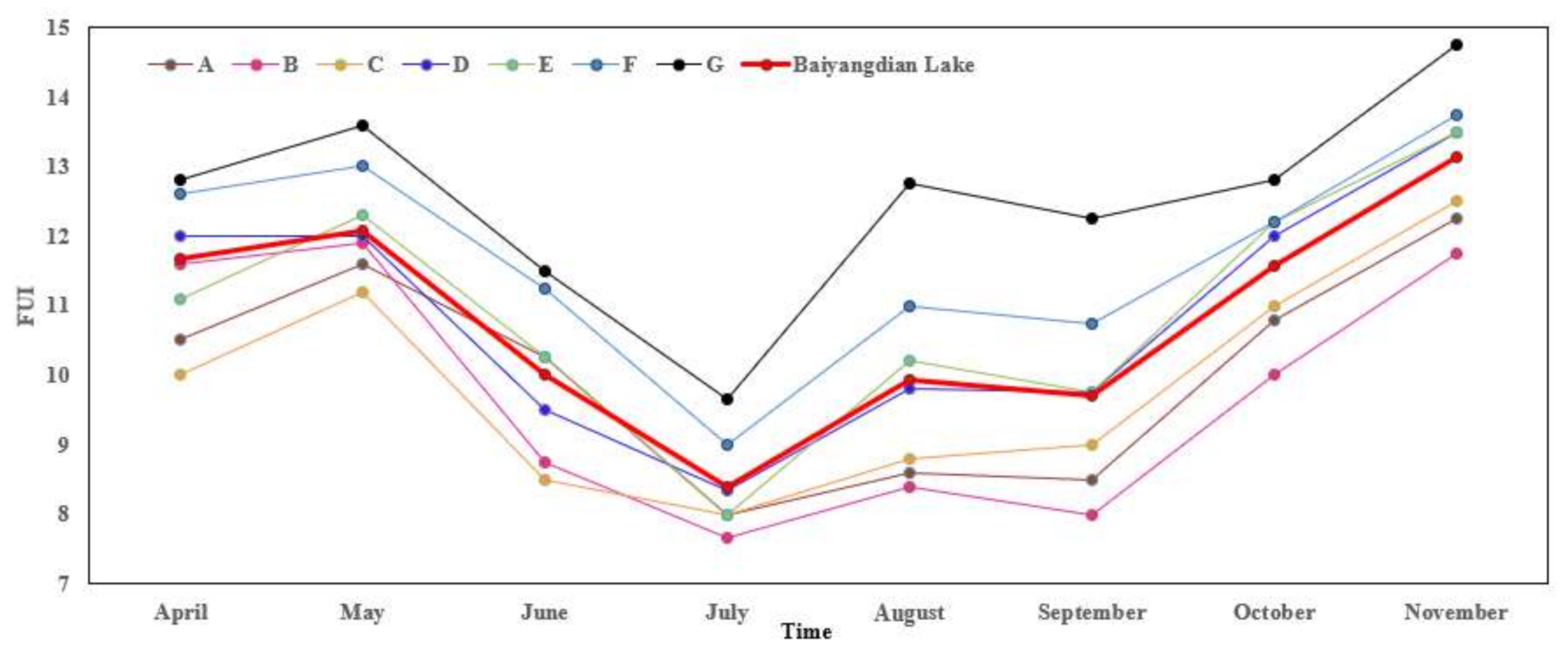
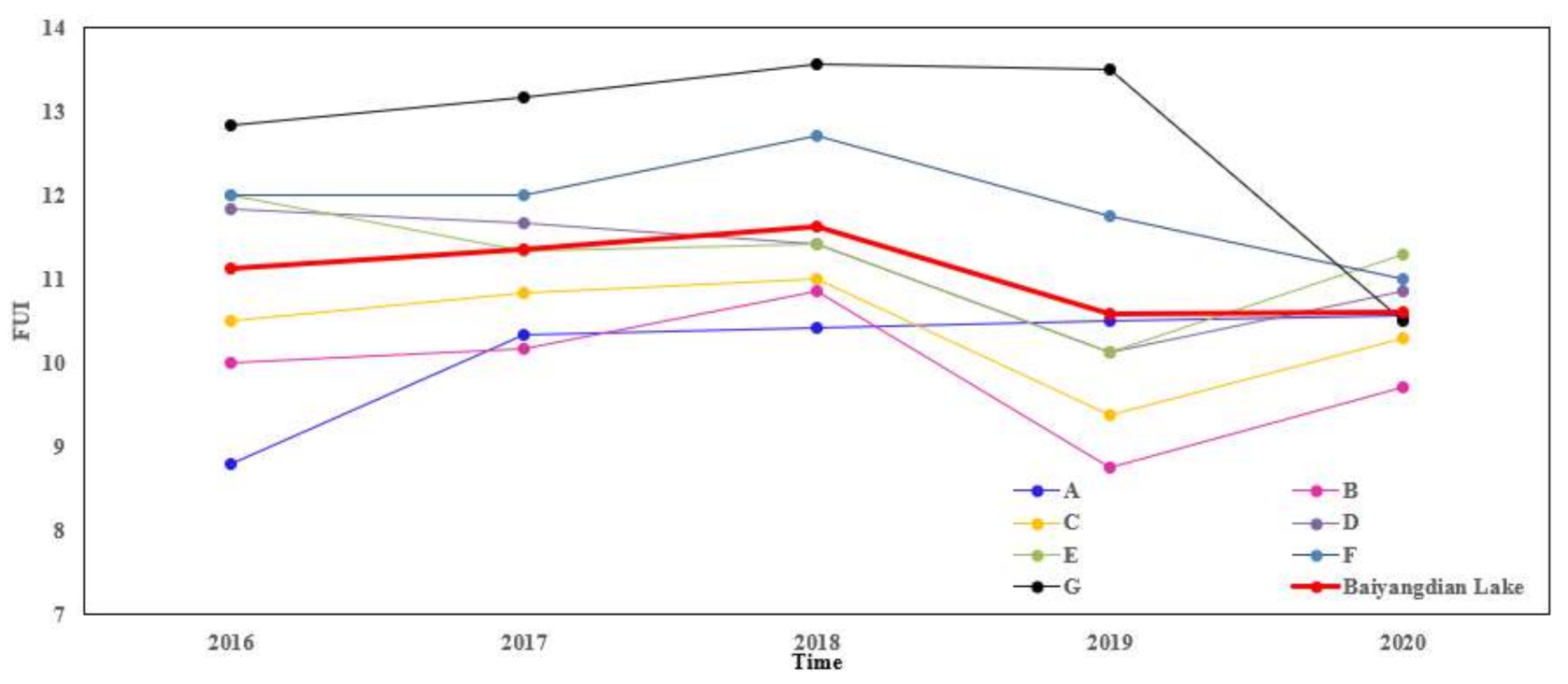
| 2016 | 2017 | 2018 | 2019 | 2020 | |
|---|---|---|---|---|---|
| April | 6 | 4 | 9 | 5 | 14 |
| May | 6 | 10 | 9 | 9 | 12 |
| June | 8 | 6 | 7 | 5 | 6 |
| July | - | 9 | 2 | 4 | 5 |
| August | 6 | 8 | 2 | 11 | 5 |
| September | 6 | 9 | 3 | 9 | 9 |
| October | 3 | 8 | 8 | 10 | 12 |
| November | - | 15 | 12 | 9 | 19 |
| Total | 35 | 69 | 52 | 62 | 82 |
| Baiyangdian | A | B | C | D | E | F | G | |
|---|---|---|---|---|---|---|---|---|
| 2016 | 11.14 | 8.8 | 10 | 10.5 | 11.83 | 12 | 12 | 12.83 |
| 2017 | 11.36 | 10.33 | 10.17 | 10.83 | 11.67 | 11.33 | 12 | 13.17 |
| 2018 | 11.63 | 10.43 | 10.86 | 11 | 11.43 | 11.43 | 12.71 | 13.57 |
| 2019 | 10.59 | 10.5 | 8.75 | 9.37 | 10.13 | 10.13 | 11.75 | 13.5 |
| 2020 | 10.6 | 10.57 | 9.71 | 10.29 | 10.86 | 11.29 | 11 | 10.5 |
Publisher’s Note: MDPI stays neutral with regard to jurisdictional claims in published maps and institutional affiliations. |
© 2021 by the authors. Licensee MDPI, Basel, Switzerland. This article is an open access article distributed under the terms and conditions of the Creative Commons Attribution (CC BY) license (https://creativecommons.org/licenses/by/4.0/).
Share and Cite
Zhao, Y.; Wang, S.; Zhang, F.; Shen, Q.; Li, J.; Yang, F. Remote Sensing-Based Analysis of Spatial and Temporal Water Colour Variations in Baiyangdian Lake after the Establishment of the Xiong’an New Area. Remote Sens. 2021, 13, 1729. https://doi.org/10.3390/rs13091729
Zhao Y, Wang S, Zhang F, Shen Q, Li J, Yang F. Remote Sensing-Based Analysis of Spatial and Temporal Water Colour Variations in Baiyangdian Lake after the Establishment of the Xiong’an New Area. Remote Sensing. 2021; 13(9):1729. https://doi.org/10.3390/rs13091729
Chicago/Turabian StyleZhao, Yelong, Shenglei Wang, Fangfang Zhang, Qian Shen, Junsheng Li, and Fan Yang. 2021. "Remote Sensing-Based Analysis of Spatial and Temporal Water Colour Variations in Baiyangdian Lake after the Establishment of the Xiong’an New Area" Remote Sensing 13, no. 9: 1729. https://doi.org/10.3390/rs13091729
APA StyleZhao, Y., Wang, S., Zhang, F., Shen, Q., Li, J., & Yang, F. (2021). Remote Sensing-Based Analysis of Spatial and Temporal Water Colour Variations in Baiyangdian Lake after the Establishment of the Xiong’an New Area. Remote Sensing, 13(9), 1729. https://doi.org/10.3390/rs13091729






